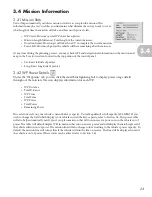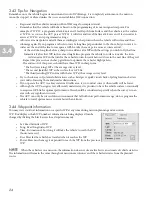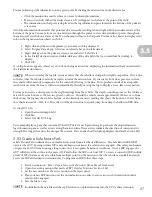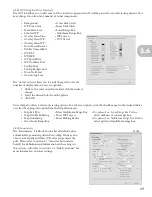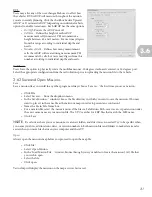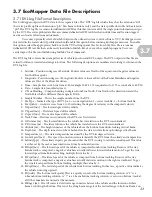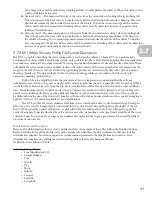
35
percentage is the amount of the water tracking cell that is usable (below the surface). When this value is zero,
surface tracking is being used.
44. Xvelocity (m/s) – The measured velocity of the water from the second down-looking velocity profiling cell.
This is the speed of the local current just below the vehicle in the direction the vehicle is heading. This is an
absolute measurement that includes the motion of the vehicle. To find the true current speed, the motion
of the vehicle and the orientation or heading of the vehicle must be taken into account. A negative value
indicates forward motion.
45. Yvelocity (m/s) - The measured velocity of the water from the second down-looking velocity profiling cell.
This is the speed of the local current just below the vehicle in the direction perpendicular to the direction
the vehicle is heading. This is an absolute measurement that includes the motion of the vehicle. To find the
true current speed, the motion of the vehicle and the orientation or heading of the vehicle must be taken into
account. A negative value indicates motion toward starboard.
3.72 DVL Water Velocity Profile File Format Description
The DVL is capable of profiling the water column above and below the vehicle. 10 beam DVLs can profile above
and below the vehicle, while 4 and 6 beam systems only profile below the vehicle. Before profiling data is recorded, the
user enable recording in VectorMap under DVL settings and define the number of cells and the size of the cells. These
cells divide the water column into a number of slices where the velocity of the water in each slice is averaged over the
length of the cell. The water velocity data for the up-looking profiles are recorded in the files with “.pfu” extensions
meaning “profile up”. The water velocity data for the down-looking profiles are recorded in the files with “.pfd”
extensions meaning “profile down”.
Both of the pfu and pfd files have the same format, but it is important to understand that the cells are
numbered consecutively as they move away from the vehicle in both directions. For example, cell 1 from the pfd file is
just below the vehicle while cell 1 from the pfu file is just above the vehicle. The up and down cells can have different
sizes. The minimum cell size should be no less than 0.2 meters. The number of cells is limited to 30 up-looking cells
and 30 down-looking cells. There can be a different number of cells in each direction and the size of the up cells can
be different from the size of the down cells. Smaller cell sizes will produce noisier data because less spatial averaging is
applied. A cell size of 1 meter is suitable for most applications.
The DVL profiles the water column several times per second, but the data is only recorded in te pfd and pfu
files once per second. It is important to understand that if a cell is located beyond the physical boundary of the sea
floor or the beyond the surface of the water, a value will still be recorded for that cell. Users will need to apply the
vertical beam data to decide whether the cell is valid or not. Also, depending on the speed and variability of the water
currents, it may be necessary to average over a number of samples in time to get a good view of the overall profile or
structure of the currents.
Profile Data Format Description
There is a lot of information in the velocity profile data files. An example of these files follows the line descriptions
below. Each line in the pfd or pfu file starts with a number that identifies the data contained on that line. For line
identification numbers less than or equal to zero, information is related to the sample time and location. Line
identification numbers one and higher contain water profile velocities and beam amplitudes.
Definitions of each line in the file:
Lines beginning with -1:
• Line Identification (-1),
• Sample Number,
• Year,
• Month,
• Day,
• Hour,
• Minute,
• Second,
• Latitude,
• Longitude.
3.7



